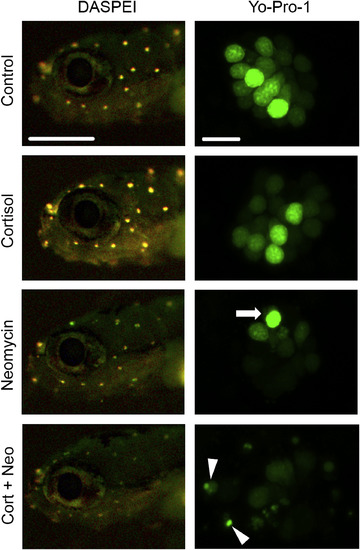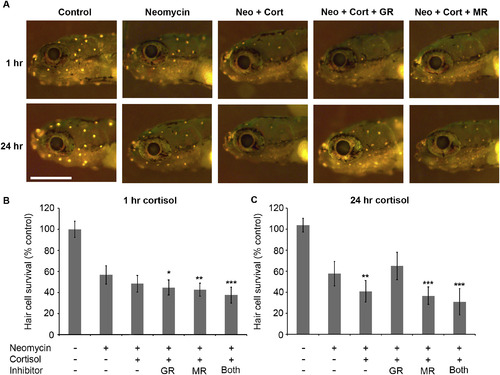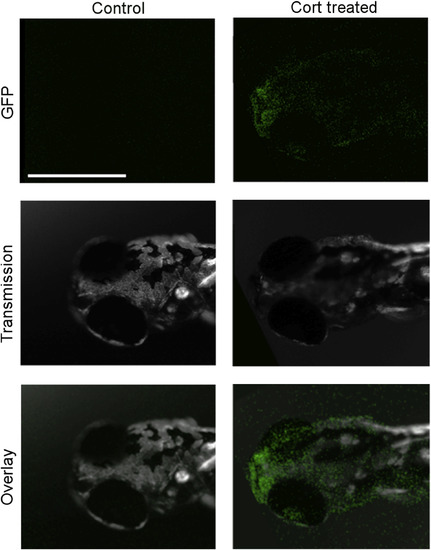- Title
-
Glucococorticoid receptor activation exacerbates aminoglycoside-induced damage to the zebrafish lateral line
- Authors
- Hayward, T., Young, A., Jiang, A., Crespi, E.J., Coffin, A.B.
- Source
- Full text @ Hear. Res.
|
Cortisol increases neomycin-induced hair cell damage.Left column shows heads of fish labeled with the vital dye DASPEI. 50 μM neomycin treatment reduces DASPEI fluorescence, which is further reduced by 24-hr incubation with 10 μM cortisol. Scale bar in right column = 400 μm and applies to all DASPEI images. Right column shows higher magnification images of individual neuromasts (all of neuromast SO2, see Raible and Kruse, 2000) labeled with the nuclear-specific vital dye Yo-Pro-1. Incubation in 50 μM neomycin reduces the total number of hair cell nuclei and leads to formation of pyknotic nuclei (arrow). 24-hr incubation in 10 μM cortisol prior to neomycin exacerbates hair cell damage. Arrowheads indicate fragmented hair cell nuclei. Scale bar in left column = 10 μm and applies to all Yo-Pro-1 images.
|
|
Cortisol-mediated sensitization depends on the GR. (A) Representative images of fish treated for 1 or 24 h with cortisol with or without pharmacological inhibition of the GR or MR, prior to treatment with 50 μM neomycin. Scale bar = 400 μm and applies to all images. (B) 1 h cortisol treatment does not significantly sensitize hair cells to neomycin damage. Co-treatment with cortisol and either the GR inhibitor RU486, the MR inhibitor epleronone, or both inhibitors, however, does lead to slightly increased hair cell loss relative to fish treated with neomycin only (1-way ANOVA: F(4,33) = 6.091, p = 0.0009). (C) 24 h treatment with the GR inhibitor RU486 in combination with cortisol prior to neomycin treatment attenuated cortisol-mediated sensitization to neomycin, but inhibition of the MR (with epleronone) was not sufficient to attenuate cortisol-mediated sensitization (1-way ANOVA, F(4,46) = 16.49, p < 0.0001). Post-hoc analysis for 1 or 24 h treatments was performed using Tukey's HSD test, *p < 0.05, **p < 0.01. ***p < 0.001, where all comparisons are relative to treatment with neomycin only. N = 6–12. Error bars = ± 1 s.d.
|
|
Exogenous cortisol increases GR transcriptional activity. Representative images of GFP fluorescence, transmission, and overlay of GFP and transmission in control and cortisol-treated SR4G transgenic fish. Scale bar = 500 μm and applies to all panels.
|
|
Glucocorticoid transcriptional activity is localized in hair cells. (Red = HCs labeled with anti-parvalbumin (parv). Green = GFP (with signal enhanced by anti-GFP), indicative of GR transcriptional activity). (A) Glucocorticoid transcriptional activity occurs in some hair cells of untreated fish (GFP+/parv+, white arrow). (B) Glucocorticoid transcriptional activity occurs in many hair cells of cortisol-treated fish (GFP+/parv+, white arrows), and in supporting cells (GFP+/parv-, white arrowhead). Scale bar = 10 μm and applies to all panels. (For interpretation of the references to color in this figure legend, the reader is referred to the Web version of this article.)
|
Reprinted from Hearing Research, 377, Hayward, T., Young, A., Jiang, A., Crespi, E.J., Coffin, A.B., Glucococorticoid receptor activation exacerbates aminoglycoside-induced damage to the zebrafish lateral line, 12-23, Copyright (2019) with permission from Elsevier. Full text @ Hear. Res.




